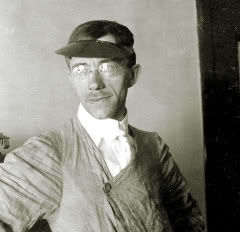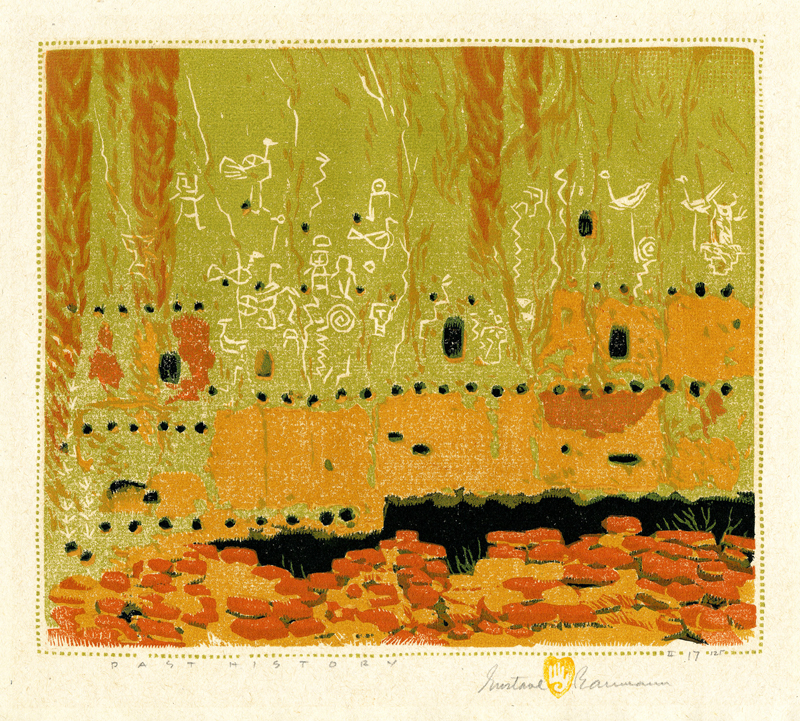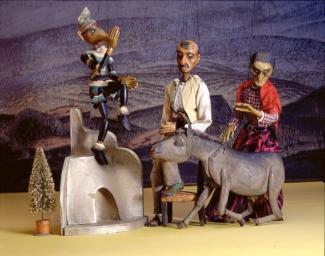A new year has come and come, and with that comes a new cycle of Printmakers You Should Know. For 2014, I've decided to celebrate a year of printmakers featured in the RMAC's collection (though admittedly I've already been doing this). Each month then, you'll learn about a new printer featured in our collections, some well known, others not so much, but all interesting.
For January, we'll kick things off with one of the more famous artistic personalities of New Mexico, and specifically Santa Fe: Gustave Baumann (1881-1971).
Baumann was born in Germany, and moved with his family to the United States when he was around 10; as a teenager he took night classes at the Art Institute of Chicago. He went to Munich in 1904 to study woodblock prints, and after his return to the States in 1908, worked as a graphic artist.
Baumann first made his way to the Southwest in 1918 to check out the Taos art scene, which by that time was gaining a reputation as one of the more intriguing and sustainable artist's groups (art colonies, unsurprisingly, are notorious for their drama). Baumann thought it was a little too crowded, so he bee-bopped over to Santa Fe, which was quite small and rustic, very different from the tourist hot spot it is today. Anyway, Baumann apparently liked what he saw, because he never left.
Baumann is best known for his work in color woodcut. He's considered one of the leading figures in the revival of the medium, which had been perfected in Japan some centuries earlier. Color woodcuts are technically difficult and time consuming to make because you have to carve each color block separately (unless you're B.J.O. Nordfeldt, and you invent the white-line technique to get around that issue). In addition to their technical finesse and sense of color, Baumann's prints are remarkable for their fairly large scale. He typically created Southwestern landscapes or pueblo scenes, and was also interested in petroglyph imagery.
http://www.museumfoundation.org
Baumann's interests weren't limited to woodcuts, however. He also carved marionettes, and for many years held puppet shows with them. The puppets aren't regularly in action anymore, not physically at least, but they're still preserved.
He also painted and sculpted. The RMAC actually has one of his more peculiar pieces:
This odd little work is called The Pathfinder. It was made around 1957, and according to his daughter, was a spoof of modern art. If you look carefully, you'll find it's not just a random assemblage of wood, but a human figure with googly eyes running frantically. Take what you will of Baumann's work, but I appreciate a sense of humor.
Want to learn more? Check out these sites:
http://www.annexgalleries.com/artists/biography/140/Baumann/Gustave
http://www.medicinemangallery.com/bio/Baumann.lasso
http://americanart.si.edu/search/artist_bio.cfm?ID=282
http://sam.nmartmuseum.org/view/people/asitem/B/17?t:state:flow=28584db6-3134-4ca5-9e1a-33dee9029e5c
And as always, you can use the RMAC's online database to see some of our Baumanns:
http://roswellmuseum.pastperfect-online.com/36727cgi/mweb.exe?request=ks
For January, we'll kick things off with one of the more famous artistic personalities of New Mexico, and specifically Santa Fe: Gustave Baumann (1881-1971).
 |
| Gustave Baumann. Image courtesy of http://www.annexgalleries.com/artists/biography/140/Baumann/Gustave |
Baumann was born in Germany, and moved with his family to the United States when he was around 10; as a teenager he took night classes at the Art Institute of Chicago. He went to Munich in 1904 to study woodblock prints, and after his return to the States in 1908, worked as a graphic artist.
Baumann first made his way to the Southwest in 1918 to check out the Taos art scene, which by that time was gaining a reputation as one of the more intriguing and sustainable artist's groups (art colonies, unsurprisingly, are notorious for their drama). Baumann thought it was a little too crowded, so he bee-bopped over to Santa Fe, which was quite small and rustic, very different from the tourist hot spot it is today. Anyway, Baumann apparently liked what he saw, because he never left.
Baumann is best known for his work in color woodcut. He's considered one of the leading figures in the revival of the medium, which had been perfected in Japan some centuries earlier. Color woodcuts are technically difficult and time consuming to make because you have to carve each color block separately (unless you're B.J.O. Nordfeldt, and you invent the white-line technique to get around that issue). In addition to their technical finesse and sense of color, Baumann's prints are remarkable for their fairly large scale. He typically created Southwestern landscapes or pueblo scenes, and was also interested in petroglyph imagery.
 |
| Gustave Baumann, Cholla and Saguaro, 1925, color woodcut. Image courtesy of http://www.invaluable.com/features/viewArtist.cfm?afRedir=true&artistRef=5f25vtdrqt |
 |
| Gustave Baumann, San Geronimo, Taos, color woodcut. Image courtesy of: |
 |
| Gustave Baumann, Hopi Katzinas, ca. 1925, color woodcut. Image courtesy of: http://www.medicinemangallery.com/bio/Baumann.lasso |
 |
| Gustave Baumann, Grand Canyon, 1934, color woodcut. Image courtesy of http://annexgalleries.wordpress.com/ |
 |
| Gustave Baumann, Past History, 1946, color woodcut, image courtesy of: http://www.annexgalleries.com/inventory/detail/THMU101/Gustave-Baumann/Past-History |
Baumann's interests weren't limited to woodcuts, however. He also carved marionettes, and for many years held puppet shows with them. The puppets aren't regularly in action anymore, not physically at least, but they're still preserved.
 |
 |
| Some of Baumann's marionettes. Image courtesy of: http://alibi.com/art/26568/The-World-by-a-String.html |
He also painted and sculpted. The RMAC actually has one of his more peculiar pieces:
This odd little work is called The Pathfinder. It was made around 1957, and according to his daughter, was a spoof of modern art. If you look carefully, you'll find it's not just a random assemblage of wood, but a human figure with googly eyes running frantically. Take what you will of Baumann's work, but I appreciate a sense of humor.
Want to learn more? Check out these sites:
http://www.annexgalleries.com/artists/biography/140/Baumann/Gustave
http://www.medicinemangallery.com/bio/Baumann.lasso
http://americanart.si.edu/search/artist_bio.cfm?ID=282
http://sam.nmartmuseum.org/view/people/asitem/B/17?t:state:flow=28584db6-3134-4ca5-9e1a-33dee9029e5c
And as always, you can use the RMAC's online database to see some of our Baumanns:
http://roswellmuseum.pastperfect-online.com/36727cgi/mweb.exe?request=ks

Comments
Post a Comment
Questions? Comments? Speak your mind here.